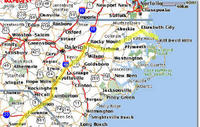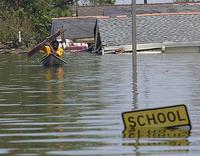-
Quake-proofing U.S. buildings
An Indian civil engineer has invented a sleeved column braces which help buildings withstand earthquakes; the sturdy brace apparatus surrounds a core of high-performance steel, but is spaced from the sides of the core; the sleeve thus absorbs and dissipates energy, but does not buckle under pressure; several large buildings in California, built in the last few years, have adopted the technology
-
-
U.S. structural engineers begin on-site damage assessments in Haiti
U.S. engineers are going to Haiti to study the earthquake and its ramifications for structural engineering; the structural engineers emergency response committee (SEER) of the National Council of Structural Engineers Associations (NCSEA) — the SEER consists of volunteer structural engineers trained in the structural engineering aspects of emergency response to earthquakes, hurricanes, and other disasters — is in talks with the U.S. government and the private sector to identify ways in which the structural engineering community can lend its talents, skills and experience
-
-
Scientists anxious about other big quakes
The Haitian earthquake may have increased the chance of a future quake in the neighboring Dominican Republic and other parts of the Caribbean; during the Haitian quake, only 30 to 60 miles of the 300-mile fault near Port-au-Prince ruptured and slid; the rest of it stayed stuck, still glued together by friction; the area that ruptured is likely to have increased the amount of strain — and the risk of quake — in other parts of the fault
-
-
Haiti’s lack of building standards major contributor to scope of disaster
One of the major contributors to the magnitude of the disaster in Haiti was the fact that there were no building codes in the country – a study done by the Organization of American States (OAS) concluded last month that many of the buildings in Haiti were so shoddily constructed that they were unlikely to survive any disaster, let alone an earthquake like the one that devastated Port-au-Prince last Tuesday
-
-
WHOI expert: Haiti quake occurred in complex, active seismic region
Most of the time, the earth’s plates do not slide smoothly past one another; they stick in one spot for perhaps years or hundreds of years, until enough pressure builds along the fault and the landmasses suddenly jerk forward to relieve the pressure, releasing massive amounts of energy throughout the surrounding area; in Haiti, the tremor was centered just 10 miles southwest of the capital city, Port au Prince, and the quake was shallow — only about 10-15 kilometers below the land’s surface
-
-
U.S. aging infrastructure a national security concern
There many immediate and long-term economic benefits to investing in shoring up the U.S. crumbling infrastructure – but investing in creating a robust and resilient infrastructure is essential for national security as well: because the United States is the world’s dominant military power, the only real way for enemies to attack the country is through its infrastructure, including cyberspace, making infrastructure resilience critical
-
-
Why the U.S. needs an infrastructure bank
The U.S. aging infrastructure will eventually constrain economic growth; government alone can no longer finance all of the nation’s infrastructure requirements; a national infrastructure bank (NIB) could fill the gap; the NIB could attract private funds to co-invest in projects that pass rigorous cost-benefit tests, and that generate revenues through user fees or revenue guarantees from state and local governments; investors could choose which projects meet their investment criteria, and, in return, share in project risks that today fall solely on taxpayers
-
-
Bruker’s Autonomous Rapid Facility Chemical Agent Monitor advances to DHS Phase IIIb
Bruker uses its proprietary RAID Ion Mobility Spectrometry (IMS) technology for the Autonomous Rapid Facility Chemical Agent Monitor Program, which is designed for long-term monitoring of ambient air for the presence of hazardous chemical vapors in the interior or exterior of critical government buildings, subways, airports and other facilities; the company says it has also developed a new product – the DE-tector — which uses next-generation IMS technology with selectivity and specificity that approaches that of mass spectrometry
-
-
The 106-foot San Clemente to be torn down, largest dam removal in California
California dam inspectors declared the San Clemente dam unsafe in 1991, at risk of collapse in a major earthquake; “In 1921, this dam was a marvel of engineering. It has fulfilled its purpose and its usefulness is behind us,” said Rob MacLean, president of the California American Water Co., which owns the dam
-
-
Haiti's earthquake was long anticipated
A group of scientists from the United States and Jamaica warned in 2008 that a fault zone on the south side of the island — the Enriquillo-Plaintain Garden fault zone — presented a danger; they predicted that a magnitude-7.2 earthquake would result if all of the strain along the fault “is released in a single event”
-
-
Flood-prone state road gets temporary fix

A section of Route 12, just north of the village of Rodanthe, North Carolina, increasingly has become flood-prone over the past decade due in part to rapid beach erosion in the area; wind-driven waves from a slow-moving mid-November storm buckled and undermined approximately 800 ft of pavement, flattened 900 ft of 15-ft to 20-ft-high sand dunes, and damaged hundreds of sandbags placed by NCDOT following a 2007 storm event; the North Carolina Department of Transportation has decided to relocate 1,800-ft-long stretch of the highway
-
-
Katrina Effect helped bolster flood defenses

Californians responded to Hurricane Katrina by approving, on 7 November 2006, a $4.1 billion bond measure for flood control; Proposition 1E was the largest single investment Californians had ever approved for upgrading the state’s flood defenses, and it was remarkable for several reasons
-
-
Levee statistics show their importance to U.S. economy
Counties with levees account for only 28 percent of the U.S. counties and only 37 percent of the U.S. land area – but they contain 55 percent of the U.S. population, more than 156 million people; the total productivity for counties containing levees was nearly 3.3 times greater than it was in those without levees; the average annual income of residents was $1,500 more, and the rate of poverty was 2 percent lower
-
-
Thermal imaging enters the mainstream
FLIR guides thermal imaging into the mainstream; FLIR, a leading thermal imaging equipment manufacturer, helps the trend by lowering its price point; a residential thermal imaging camera can now be purchased for $3,500
-
-
Security and building design: A decade of change and adaptation
The cumulative influence of major building security-related events — the 1983 bombing of the U.S. Marine barracks in Beirut, Lebanon, the 1996, the destruction of the Khobar Towers in Dhahran, Saudi Arabia, the 1998 bombings of the U.S. embassies in Tanzania and Kenya, the first World Trade Center bombing in 1993, the Oklahoma City bombing of the Alfred P. Murrah Federal Building happened in 1995, and the 2001 attack on the Twin Towers – have led architects and engineers to rethink building security
-
More headlines
The long view
Water Wars: A Historic Agreement Between Mexico and US Is Ramping Up Border Tension
As climate change drives rising temperatures and changes in rainfall, Mexico and the US are in the middle of a conflict over water, putting an additional strain on their relationship. Partly due to constant droughts, Mexico has struggled to maintain its water deliveries for much of the last 25 years, deliveries to which it is obligated by a 1944 water-sharing agreement between the two countries.
Trump Is Fast-Tracking New Coal Mines — Even When They Don’t Make Economic Sense
In Appalachian Tennessee, mines shut down and couldn’t pay their debts. Now a new one is opening under the guise of an “energy emergency.”
Smaller Nuclear Reactors Spark Renewed Interest in a Once-Shunned Energy Source
In the past two years, half the states have taken action to promote nuclear power, from creating nuclear task forces to integrating nuclear into long-term energy plans.
Keeping the Lights on with Nuclear Waste: Radiochemistry Transforms Nuclear Waste into Strategic Materials
How UNLV radiochemistry is pioneering the future of energy in the Southwest by salvaging strategic materials from nuclear dumps –and making it safe.
Model Predicts Long-Term Effects of Nuclear Waste on Underground Disposal Systems
The simulations matched results from an underground lab experiment in Switzerland, suggesting modeling could be used to validate the safety of nuclear disposal sites.
